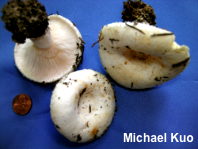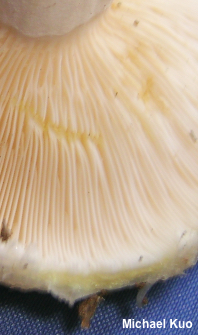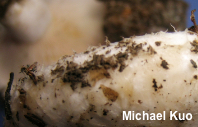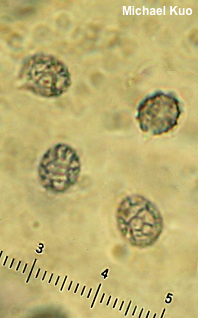| Major Groups > Gilled Mushrooms > Pale-Spored > Milky Caps > Lactarius resimus |

|
Lactarius resimus [ Basidiomycota > Russulales > Russulaceae > Lactarius . . . ] by Michael Kuo Lactarius resimus is associated with birches and pines, primarily in northern and montane regions. It features a non-zoned, whitish cap with a pubescent margin. Like all milky caps it exudes a milk when sliced; in Lactarius resimus the milk is whitish as exuded but turns to yellow within a few minutes of exposure to air. The stem lacks potholes, and the taste is acrid to bitter (sometimes slowly). In Europe the species is well-characterized and can be fairly easily separated from look-alikes on the basis of tree association, the pubescent cap margin, and the lack of concentric zones of color. In North America, however, there may be several versions of Lactarius resimus, and the group is in dire need of critical study. Description: Ecology: Mycorrhizal with birches and pines; growing alone, scattered, or gregariously; summer and fall; originally described from Sweden; widespread in Europe; occasionally reported in western Asia; widely reported in North America (but see comments above), especially in northern and montane regions. The illustrated and described collection is from Colorado. Cap: 4–10 cm; convex with an inrolled and finely hairy margin when young, becoming shallowly depressed, flat, or shallowly vase-shaped; sticky when young and fresh, but soon dry; bald or, near the margin, finely hairy; roughened; whitish, with yellowish discolorations; not featuring concentric zones of color. Gills: Running down the stem; close or crowded; short-gills frequent; whitish becoming slightly pinkish. Stem: 2–4 cm long; 1–1.5 cm thick; more or less equal; dry; without potholes; bald; colored like the cap; becoming hollow. Flesh: White; slowly yellowed by latex when sliced. Milk: Scant; white as exuded but turning yellow within a few minutes of exposure to air; staining tissues yellow. Odor and Taste: Odor not distinctive; taste acrid/bitter. Spore Print: Creamy. Microscopic Features: Spores 6–8 x 5–6 µm; broadly ellipsoid; ornamentation as amyloid spines and ridges extending to 0.5 µm high, forming partially to nearly completely reticulated patterns. Macrocystidia inconspicuous; to 45 x 5 µm; fusiform; hyaline in KOH; smooth; thin-walled. Pileipellis an ixocutis; hyaline to yellowish in KOH. REFERENCES: (Fries, 1821) Fries, 1838. (Burlingham, 1907; Hesler & Smith, 1960; Hesler & Smith, 1979; Smith, Smith & Weber, 1979; Schalkwijk-Barendsen, 1991; Montoya & Bandala, 1996; Methven, 1997; Heilmann-Clausen et al., 1998; Basso, 1999; Kränzlin, 2005; McNeil, 2006; Bessette et al., 2009; Geml et al., 2009; Verbeken & Vesterholt, 2012; Buczacki et al., 2013; Methven, 2013; Siegel & Schwarz, 2016; Læssøe & Petersen, 2019.) Herb. Kuo 08281105. Herb. DBG F-022676. This site contains no information about the edibility or toxicity of mushrooms. |
© MushroomExpert.Com |
|
Cite this page as: Kuo, M. (2021, June). Lactarius resimus. Retrieved from the MushroomExpert.Com Web site: http://www.mushroomexpert.com/lactarius_resimus.html |



